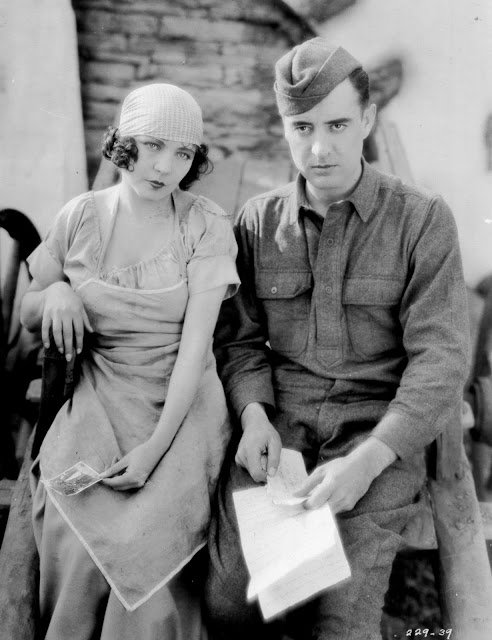The Great War's Greatest Telling
 |
| How It Was Every Night at Broadway's Astor Theatre --- and For 96 Weeks |
The Big Parade (1925) Puts Metro On The Map
Watch this and wonder how stardom got away so suddenly from John Gilbert, who'd have hit after resounding hit in late silent days, then come crashing to earth once talkies made him passé. I'd argue Jack's a best performance of the whole voiceless era here; understated, dynamic when called for, a romancer after believable fashion of ordinary guys who'd be watching. Gilbert had rare capacity for coming down to earth when parts called for him to do so. Shave the mustache and he'd be you or me (Burt Reynolds managed a same thing much later). The secret may have been frankly ordinary looks the man had when bereft of dash or sash. You'd not be amiss confusing him with the Lion's Club chairman next door, this of course enabling Gilbert to play a range of characters wider than lead men elsewhere with more glamour to shed whenever conventional parts called.
The Big Parade was a smash that passed into legend; horse-backed police and bus drivers remembered well the 96 weeks it ran to capacity attendance on Broadway ... certainly Metro bookkeepers kept its record business among treasured souvenirs. The thing began more as a programmer, but was upticked to a super-special by Irving Thalberg once he saw potential for a hit after legit What Price Glory? example. Director King Vidor and star Gilbert got the fever too. By the time Big was done parading, all down to soldier extras knew it would do historic biz. War performed well so long as scale was large. Each of studios that could afford it seemed to be aboard with big-scale battle enactment. WWI was going on ten years' past and maybe wounds had healed sufficient to regard the scrap on entertainment terms. Agonies of war would herein be revealed, but only after first-half's serve of comedy enough to fill out any three of service knockabouts done by, for instance,
In fact, it was laughter that propelled much of repeat march to Parade boxoffices. Audiences loved, and sent friends back to see, doughboy hijinks wherein newcomer Karl Dane made impression enough to spin off an entire series of comedies with diminutive George K. Arthur. Metro would even retread The Big Parade to extent of Buster Keaton and Doughboys, a hit feeding off good will from the bigger attraction. A simple scene of John Gilbert teaching French girl Renee Adoree to chew gum became one of those precious moments recalled into old age by filmgoers. The Big Parade's mood swing in its second half was what lent stature. We'd gotten to know these boisterous boys and so felt impact greater for their being hurled into combat. Random death is captured in long shot marching where we see casualties drop at a distance. It's all so casual and still has capacity to shock. Profanity comes thick and unexpected: God damn this and that of trench warfare once we're past point of no return. Gilbert's shell-hole scene with a wounded German goes minutes without a cut, like crouching down among them. Maybe it's as well we had laughs coming in, as these battles can still put one through a wringer.
This then, was the big picture that qualified King Vidor for biggest pictures over a thirty year period to come. He'd been directing a long while before Parade, but from here he'd join a short list of men who could be trusted to paint large murals. Northwest Passage, Duel In The Sun, War and Peace, and finally, Solomon and










Comments
Post a Comment